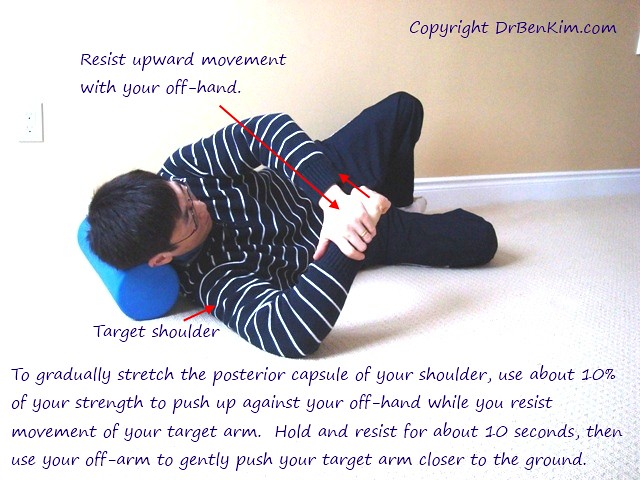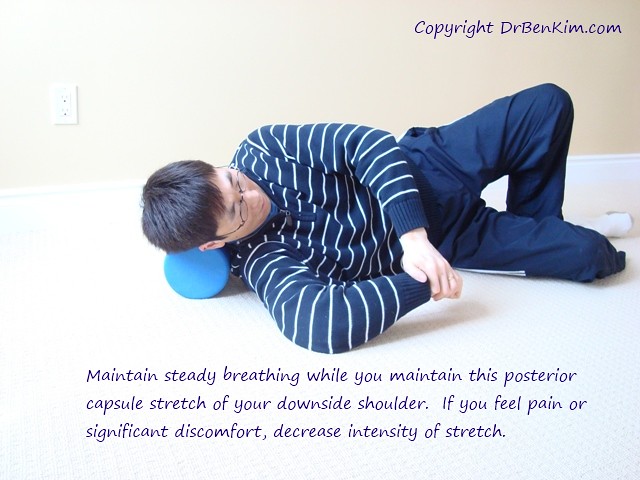You are here
Essential Movement Patterns for Preventing Shoulder Impingement, Frozen Shoulder, Bursitis, and General Shoulder Stiffness
Where there is shoulder pain due to impingement, frozen shoulder, or subacromial bursitis, an often overlooked root cause is a tight shoulder capsule.
What is your shoulder capsule?
It's a series of ligaments that surround and stabilize your shoulder joint, which is where your upper arm bone (humerus) attaches to your shoulder blade (scapula).
For a number of reasons, the back and lower portions of your shoulder capsule can become tight over time, which prevents proper downward gliding of the top of your arm bone whenever you elevate your arm, which can lead to pain and inflammation associated with impingement, adhesive capsulitis, and bursitis in this area.
It's a lot easier to show you how this works than to describe it, so before you read further into this post, I encourage you to take a moment to view the following video clip:
So let it be clear that the purpose of this post is to show you how to effectively stretch the posterior and inferior portions of your shoulder capsule, which will help ensure that your arm bone can go through normal downward gliding with all overhead activities, which is essential to preventing common shoulder ailments like impingement, frozen shoulder, and bursitis.
How to Stretch the Back and Lower Portions of Your Shoulder Capsule
Before reading any further, please take a moment to examine the three photos below. Seeing the steps involved in these photos should help you fully understand how to take your shoulder through this exercise.
To restore healthy tone and length to the posterior and inferior portions of your shoulder capsule, begin by lying on your side with your head resting comfortably on a few pillows or a foam roller.
Position your down-side shoulder so that your upper arm bone and your chest form a 90 degree angle along the floor, and have your forearm point right up to the ceiling to form another 90 degree angle between your upper arm and forearm, like the starting position for arm wrestling, but while you're lying on your side.
In most cases where there is tightness of the posterior and inferior shoulder capsule, there is also tightness of the muscles that lie on top of the capsule at the back of the shoulder - the primary muscles in question include the posterior belly of the deltoid, infraspinatus, and teres minor. Tightness in these muscles can inhibit your ability to stretch out the underlying capsule. So to loosen your posterior and inferior shoulder capsule, it's a good idea to begin by relaxing these muscles using the technique described below.
Use your other hand to provide resistance while you use about ten to twenty percent of your strength to push the hand of your down-side arm toward the ceiling. This will activate your posterior deltoid, infraspinatus, and teres minor, and after about a ten-second hold, allow your down-side arm to completely relax and use your other hand to gently push the hand of your down-side arm toward the ground in front of your abdomen. As you bring your down-side arm toward the ground, you'll likely feel some resistance in the back of your target shoulder, and once you feel a comfortable stretch, hold this position for however long is comfortable, anywhere from 10 seconds to a minute or two is fine, just go by what feels right in the moment. Be sure to maintain steady breathing throughout.
Keep your down-side arm in the same position, and resist again with your other hand while you use ten to twenty percent of your strength to push your down-side hand toward the ceiling. Apply enough resistance with your other hand to ensure that your arm doesn't actually move; the goal is to once again activate the muscles that surround the back of your shoulder. After a ten-second hold, relax your down-side arm and use your other hand to gently pull your target arm even closer to the ground in front of your abdomen.
The idea is to contract the muscles that surround your shoulder capsule, as this will allow them to more fully relax once you stop using your down-side arm and allow it to be pulled toward the ground in front of your abdomen. The more fully relaxed these muscles are, the more effectively you can stretch the ligamentous capsule that you're targeting.
Repeat this cycle, taking your target arm closer to the ground with each set. But never pull it so low that you experience significant pain or discomfort; the goal is to feel a solid stretch in the back of your target shoulder.
Once you get as low as you think you can realistically get per session, use your off-hand to hold your target arm in that position and maintain it for as long as you can, up to a maximum of 20 minutes. For lasting changes in capsule length and tone, you should aim to maintain this stretch for about 20 minutes per session when you are first beginning with this movement pattern.
If you ever feel pain or even cramping of any muscles, stop and allow your target arm to fully relax, and wait a few minutes before trying this stretch again. You want to aim for gradual improvement; in many cases, I find that it can take several months to see lasting change in this area. But once the posterior and inferior portion of your shoulder capsule is healthy, your humerus will be able to glide inferiorly as it should to allow for arm elevation without impingement and associated pain.
Please also note that after holding this stretch for up to 20 minutes, your shoulder muscles may feel like they want to cramp, so be sure to take your time in allowing your target arm to unravel from this position.
If you have any questions or comments on this technique, please use the comments section below.
Please note: If you have dislocated your shoulder before, or you know that you have hyper-flexible joints, be sure to consult with your physician before trying this stretch. Generally, I feel it is best to avoid this stretch when there is a history of shoulder dislocation(s).









